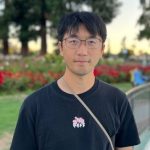 Guodong Zhu
Guodong Zhu
Graduate Student, Electrical and Computer Engineering
Ndukaife Research Group
Nanophotonics explores how light interacts with matter at the nanoscale. By engineering periodic nanostructures—such as metamaterials, metasurfaces, and photonic crystals — we can precisely control propagation and confinement of light. These capabilities enable highly sensitive biosensing, advanced imaging, and subwavelength optical trapping.
In Professor Nudukaife’s lab, my research focuses on employing both dielectric and plasmonic nanostructures to create high-Q-factor, high-field-intensity platforms for sensing and thermal emission. In particular, developing metasurfaces that support bound states in the continuum (BIC), which display exceptionally narrow linewidths. BICs are a special class of resonances with a theoretically infinite Q factor. Their topological nature allows great flexibility in metasurface design: for example, merging multiple BICs with different topological charges can further boost the Q factor while also improving fabrication robustness. We can even combine BICs with regular resonances to form electromagnetically induced absorption, facilitating near-unit absorption in metal-based thermal emitters.
Designing metasurfaces can be time-consuming, and relying solely on human intuition often falls short of achieving the best solutions due to the complexity of optical materials and structures. Inverse design methods, such as optimization algorithms and deep learning, make it far easier to discover configurations that are impossible to find via conventional approaches. I am currently exploring topological optimization and generative models to create metasurfaces based on metal structure with flat-band properties.
One of the most exciting aspects of my work is fabricating the designs and verifying that they match theoretical predictions. Every time I observe a perfectly patterned nanostructure through scanning electron microscopy (SEM), I feel like I’m part scientist, part artist. E-beam lithography (EBL) is both the most critical and the most challenging fabrication step, so every time I spend a significant amount of time fine-tuning the parameters to ensure maximum precision. I also appreciated to VINSE for providing excellent spin-coating and development recipes, which make it possible to bring my theoretical designs into reality.
My VINSE Experience
I feel incredibly fortunate to work at VINSE, which offers not only world-class equipment but also exceptionally supportive staff. They always respond to my questions promptly and effectively. Outside of the FGH building, the cleanroom is my second home. Sometimes I spend an entire day there, running sequential processes like depositing silicon with PECVD, patterning via E-beam lithography (EBL), creating hard masks in the multimode chamber, and then etching with RIE. Watching a computer-modeled design become a physical structure is thrilling, and I’m grateful for the expert maintenance of these instruments, which keeps everything running smoothly.
I have also taken two VINSE summer short courses, whose intensives schedules helped me quickly develop new skills. Through these courses, I learned how to fabricate microfluidic channels and use Atomic Force Microscopy—both of which have been invaluable to my research. I am truly thankful to VINSE for providing such advanced facilities and educational programs, which have greatly propelled my scientific journey.